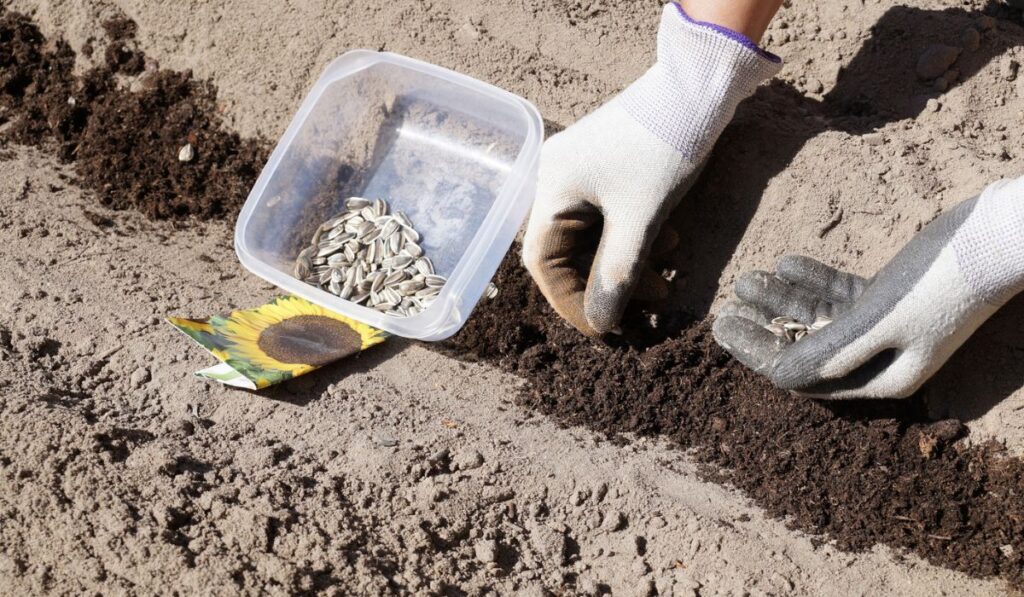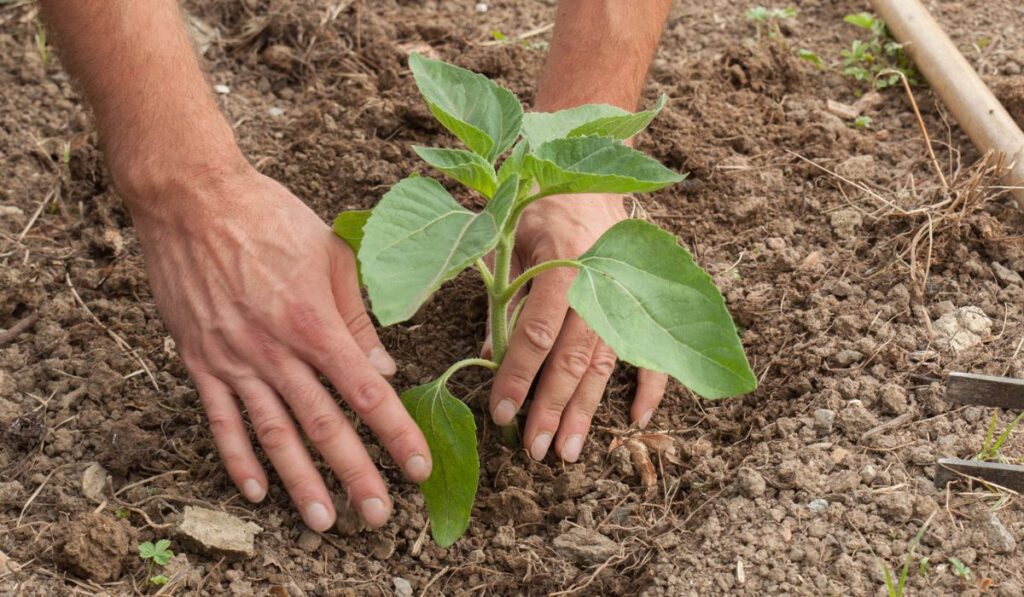Sunflowers are a great choice for anyone looking to brighten up their garden. These yellow plants aren’t only stunning; they’re also inexpensive and easy to care for. But when should you plant sunflowers, and how should you care for them?
Sunflowers should be planted in late spring, when the soil is between 70 and 85 degrees Fahrenheit. Plant them directly in well-fertilized soil and make sure they have enough room to thrive. As they grow, sunflowers need to be watered every few days to ensure the soil stays moist.
Let’s take a closer look at how to plant sunflowers, how to take care of them, and how to protect them from the wind and pests.
When Should You Plant Sunflowers?

Most sunflowers will grow and thrive when the soil is between 70 and 85 degrees Fahrenheit. You’ll want to plant the sunflowers just before it reaches this temperature, but make sure the ground temperature is at least over 60 degrees.
In most areas, this means late spring will be ideal. In colder states, however, it might mean planting them when the weather has rolled into summer, giving the sunflowers a shorter lifespan. In warmer states, they’ll have to be planted earlier, since the soil might get too hot for them to grow properly.
Sunflowers can’t grow in the winter, so any soil that’s particularly cold isn’t going to work. In states where the summers are mild, sunflowers may still be able to thrive, but they’ll still need at least six hours of sunlight to get a good chance at survival.
How to Prepare the Soil for Planting Sunflowers
The first thing you should know is that the soil needs to be rich in nutrients. This means using composted manure or a slow-release fertilizer (on Amazon).
You don’t need to worry too much about the pH of the soil, as sunflowers aren’t as fussy as other plants. However, for best results, the soil should have a pH of around 6.0 to 7.5. You can buy a tester (on Amazon) to be sure.
You should make sure the soil isn’t too compacted. Sunflower roots like to stretch out and need room to do so in order to produce the most beautiful flowers. If the soil is compacted, the flowers may still be able to grow, but they won’t be as impressive as they would have been otherwise.
You also need to choose your spot well. The more sunlight that it has, the better. Sunflowers enjoy around eight hours of sunlight a day, and while they may grow on less, you won’t see the best results — just like if the soil isn’t ideal.
It’s also a good idea to pick a spot that’s sheltered from the wind, as these plants are pretty fragile. Next to a privacy fence or a building is best.
How to Plant Sunflowers

You only need to plant sunflowers around an inch or an inch and a half deep into the soil, but you should make sure they’re 2-3 inches apart to provide them with room to grow. Many gardeners plant multiple seeds and then, when the plants are a few inches tall, they leave the best ones and cut out the rest.
You’ll want to plant the sunflower seeds (on Amazon) directly into the soil, rather than transplanting them from somewhere else (such as a pot inside the home).
What Care Do Sunflowers Need?
Although beginners tend to give sunflowers a lot of fertilizer as they grow, this can be a big mistake. It can make the stems weak, meaning they’re more likely to break in the wind. So feed the sunflowers sparingly, and try not to oversaturate the base of the sunflowers.
You should water your sunflowers every few days, ensuring they have plenty of water. The roots need it to grow and they will likely die without it.
How Tall Can Sunflowers Grow?
How tall a sunflower can grow depends on the variety. Some of the most common varieties include:
- The Teddy Bear sunflower grows to around three feet, making it a popular choice for those who don’t want sunflowers to take over their garden.
- The Sunrich Gold sunflower has been known to grow to six feet tall.
- The Autumn Beauty sunflower can get as tall as seven or eight feet.
- The Mammoth sunflower can come in at a record-breaking 16 feet!
It’s important to choose your variety carefully if you have strong feelings about the height.
Can You Harvest Sunflowers?
If you want to harvest sunflowers to give them as a gift or have them displayed indoors, it’s easy to do so. Cut the stems right before the head of the flower blooms for the longest lifespan, and remember to give them a container that provides support — they have weak stems even after being cut.
Are Sunflowers Annual or Perennial?
To understand the difference, it’s important to know the difference between the two terms. Annual means that the sunflowers will bloom once, last for the season, and then die. They will need to be replanted the next year.
Perennial means that you won’t have to re-plant. Although the flowers may die, the plant will remain and produce more the next time it’s warm enough.
Most sunflowers are annual. Some rarer varieties can be perennial, however, so if you don’t want to go to the trouble of replanting, you need to ensure you seek these specific ones out.
Why Do Sunflowers Face the Ground?
Sunflowers face the ground so that when they drop seeds, they fall into the ripe soil. This allows more sunflowers to grow. Sometimes, annual sunflowers will even give the illusion of being perennial because the seeds drop into the ground and, year after year, they come back.
Do Sunflowers Need Bee Pollination?

Sunflowers do indeed need bee pollination to thrive. The good news is that you don’t have to worry about this too much. Bees will naturally be attracted to the sunflowers, and you should ensure that any protection you put out against other predators doesn’t deter or stop these insects.
Are Sunflowers Good for Beginners?
For the most part, sunflowers are good plants for beginners as long as the necessary care is provided. Sunflowers need to be frequently watered but are relatively low-maintenance and cheap to grow.
Because they’re normally annual plants, there’s also no pressure to keep them alive for the next year and you can restart if you make a mistake or neglect them.
What Problems Come With Growing Sunflowers?
Although sunflowers are relatively easy to grow, there are some common problems that owners have to overcome to get the best results:
Pests
Pests are the most common reason that a sunflower might die. There are many bugs and rodents that will gladly eat away at the flower. While bees are necessary for pollination, consider protecting your plants from other pests.
For example, leaving garlic and onion in a wide berth around the sunflowers can deter mice and rats.
Mites and other small bugs are also a problem for sunflowers. A good solution is to use a vegetable spray oil (on Amazon). Spray a light coat over the sunflowers; it won’t hurt them, but it should prevent other bugs from crawling all over them.
Diseases
It’s not uncommon for soil to hold diseases that might kill a sunflower. One reason for this is that vegetables might have once grown there, and the conditions to grow vegetables are very different from the ones used to grow flowers. They often don’t mix well.
Over Fertilization
Although you might think that more food is always better, it’s actually pretty easy to give too much to a sunflower. You should always err on the side of caution when it comes to fertilization.
Planting Them Too Close Together
Sunflowers need room to grow. If you’re concerned about planting them too close together, then you can plant more seeds than necessary and keep an eye on them as they grow. You can then take away the ones that aren’t thriving as well, leaving plenty of room for the best ones.
Failing to Provide Wind Protection
Sunflowers come with a combination of a heavy head and a fairly fragile stem. That means that it’s easy for them to break in the wind.
While a combination of frequent watering and sparse feeding will help to protect them from stem breakage, you also need to think about their location. A strong gust of wind can take out even the best-cared-for sunflowers, so there’s often no substitute for a tall fence.
For the most part, though, your sunflowers should thrive as long as you pay attention to them and do your research. Make sure you’re also aware of which variety you picked, so that you know how approximately how tall they’ll grow.
The great thing about these annual plants is that if you make a mistake or they don’t turn out how you hoped, you can try again next year. And even if your sunflowers turn out amazing, you’ll have to do it all over again a few months later!
